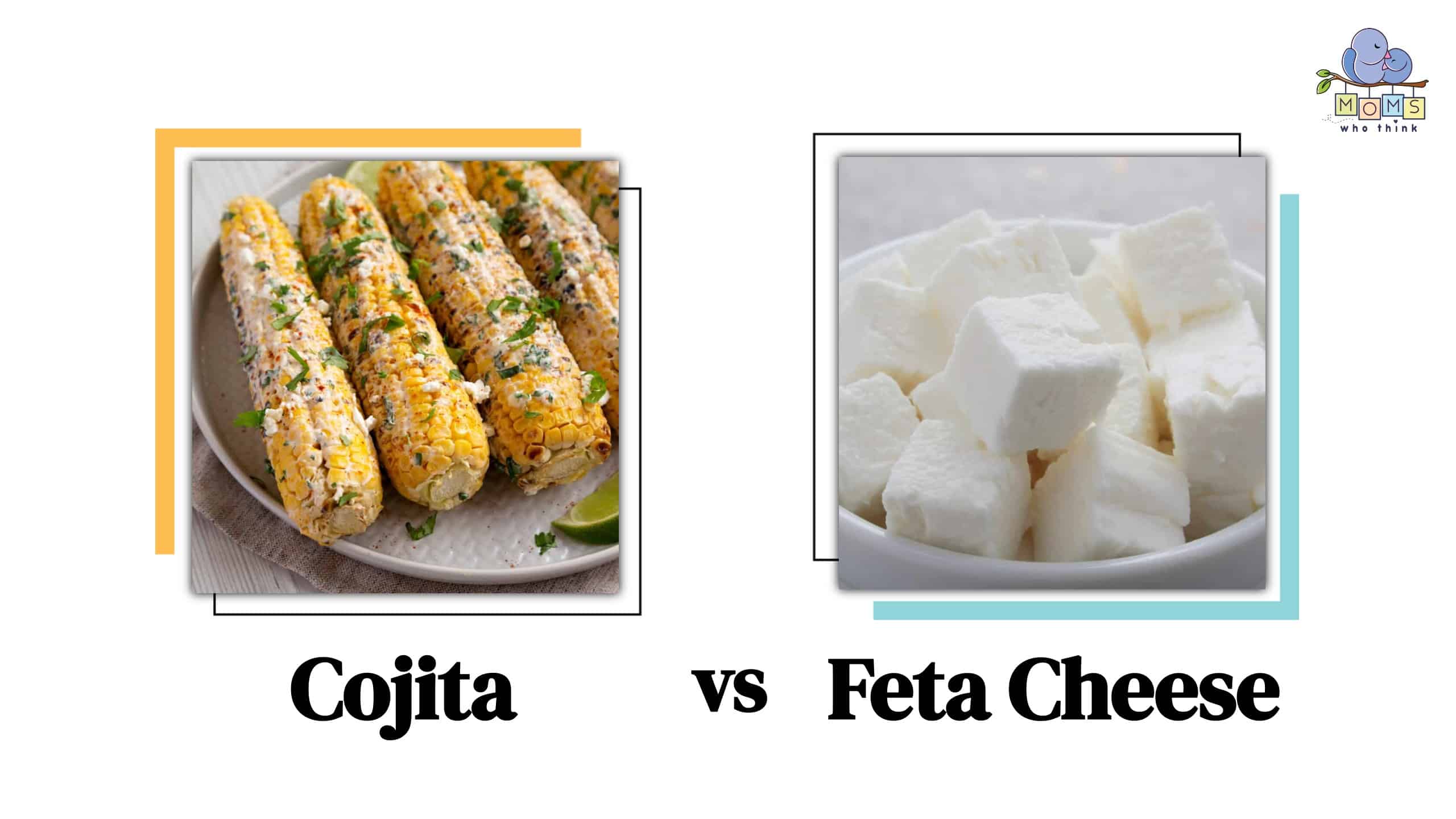Finding ways to make a quick and delicious meal for your family can be a challenging endeavor. Whether you're trying to come up with a last-minute dinner idea or meal prepping for the week ahead, having the right ingredients on hand can make all the difference.
In this post, we're comparing two popular cheeses, cotija and feta, to help you decide which one to use with your next meal. While these cheeses appear similar, they differ in terms of flavor, texture, and culinary uses. Understanding the difference between these two cheeses will help you choose the right one for your next recipe.
- The must-have convenient reference guide for every home cook!
- Includes more than 8,000 substitutions for ingredients, cookware, and techniques.
- Save time and money on by avoiding trips to grab that "missing" ingredient you don't really need.
Cotija vs. Feta Cheese: What Is the Difference?
While cotija and feta cheese may look similar at first glance, they have several differences. Cotija cheese is drier and saltier than feta cheese and it's commonly used in Mexican cuisine. Feta cheese has a tangy, sour taste and is commonly used in Greek and Mediterranean dishes.
Here's an in-depth look at each type of cheese.
What is Cotija?

©Chatham172/Shutterstock.com
Cotija is a Mexican-style cheese that's made from cow's milk. It's unique in that the cheese itself is named after a town in Mexico. Let's take a deeper look at what sets this cheese apart from feta.
Origin
This cheese is named after the town of Cotija in the state of Michoacán, Mexico, where it originated. It has been made for hundreds of years in the region and is a staple in Mexican cuisine as it's known for its versatility.
Characteristics and Texture
Cotija cheese is white, crumbly, and dry, depending on how long it's been allowed to age. This cheese is unique in that there are two different variations: “fresh” and “aged.” Fresh cotija cheese is softer and has a milder flavor, similar to queso fresco. Aged cheese is firmer, saltier, and has a more pronounced flavor, similar to parmesan.
Flavor
Cotija cheese has a strong and slightly salty flavor. As mentioned, its flavor will depend on how long the cheese has been allowed to age with fresher versions tasting similar to mild feta, and aged versions tasting similar to parmesan or Romano cheese. The saltiness of cotija can also vary depending on how it's made, with some varieties being saltier than others.
Production
Cotija cheese is made from cow's milk and is typically curdled using rennet. After the milk has curdled, the curds are drained and shaped into molds, typically in the form of flat, round disks. Once the cheese has been shaped into disks, it is typically coated with salt and left to dry. This process helps to give cotija cheese its distinctive salty flavor and crumbly texture.
The cheese is then left to dry and age for several weeks up to several months with the aging process depending on what kind of cotija is being made, fresh or aged.
Popular Uses
Cotija cheese is commonly used either crumbled or grated in Mexican cuisine as a topping or garnish for tacos, tostadas, and enchiladas. It can also be used in salads, soups, and dips. Its most popular use is on elote, also known as Mexican street corn.
It's worth noting that cotija does not melt well. Because it's a firm and crumbly cheese, it holds its shape well under heat, and while it may soften, it does not fully melt.
Nutritional Value
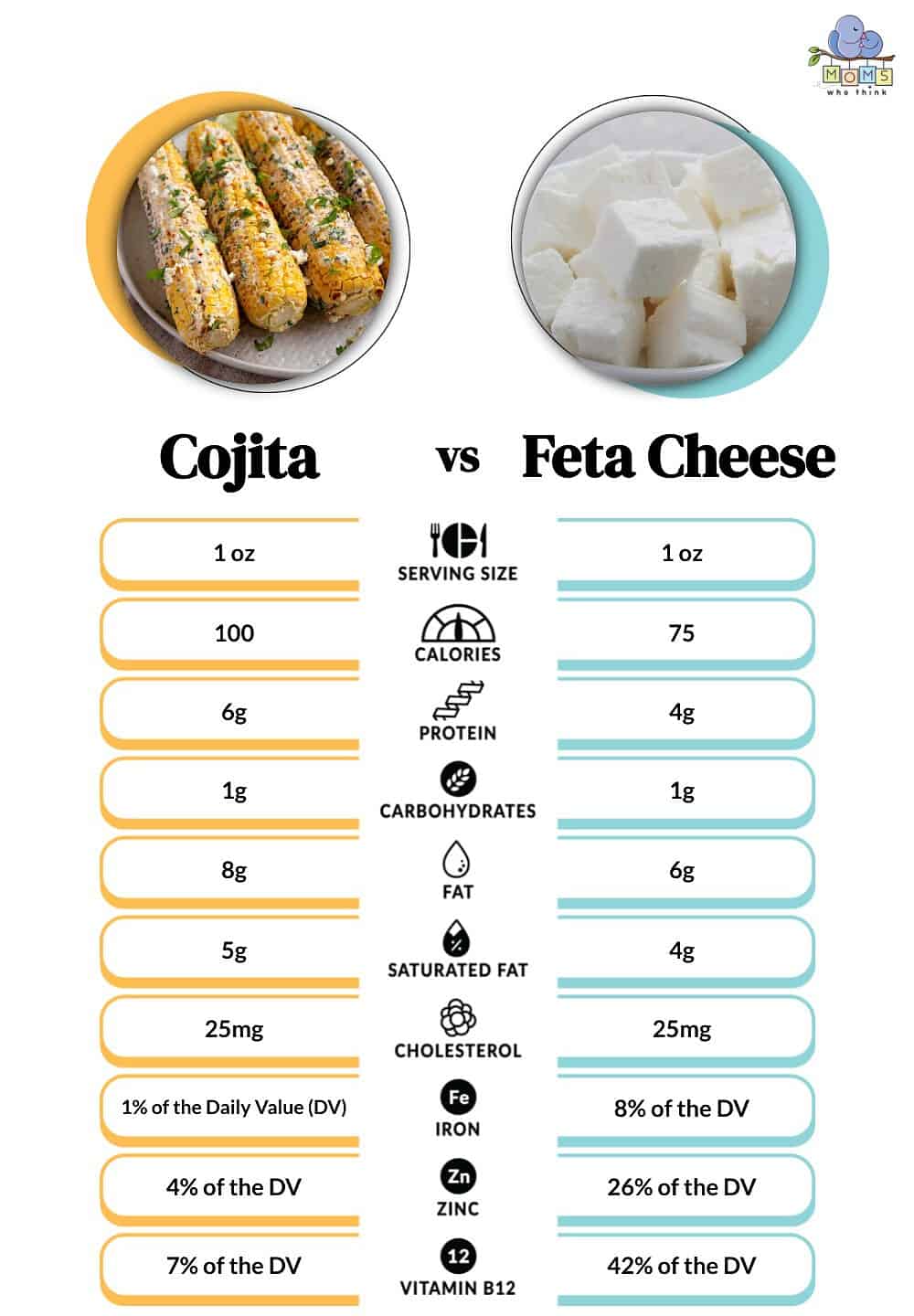
©
While cotija is also a good source of protein and calcium, it's also higher in fat and calories than feta cheese. It should be consumed in moderation as part of a balanced diet.
What is Feta Cheese?
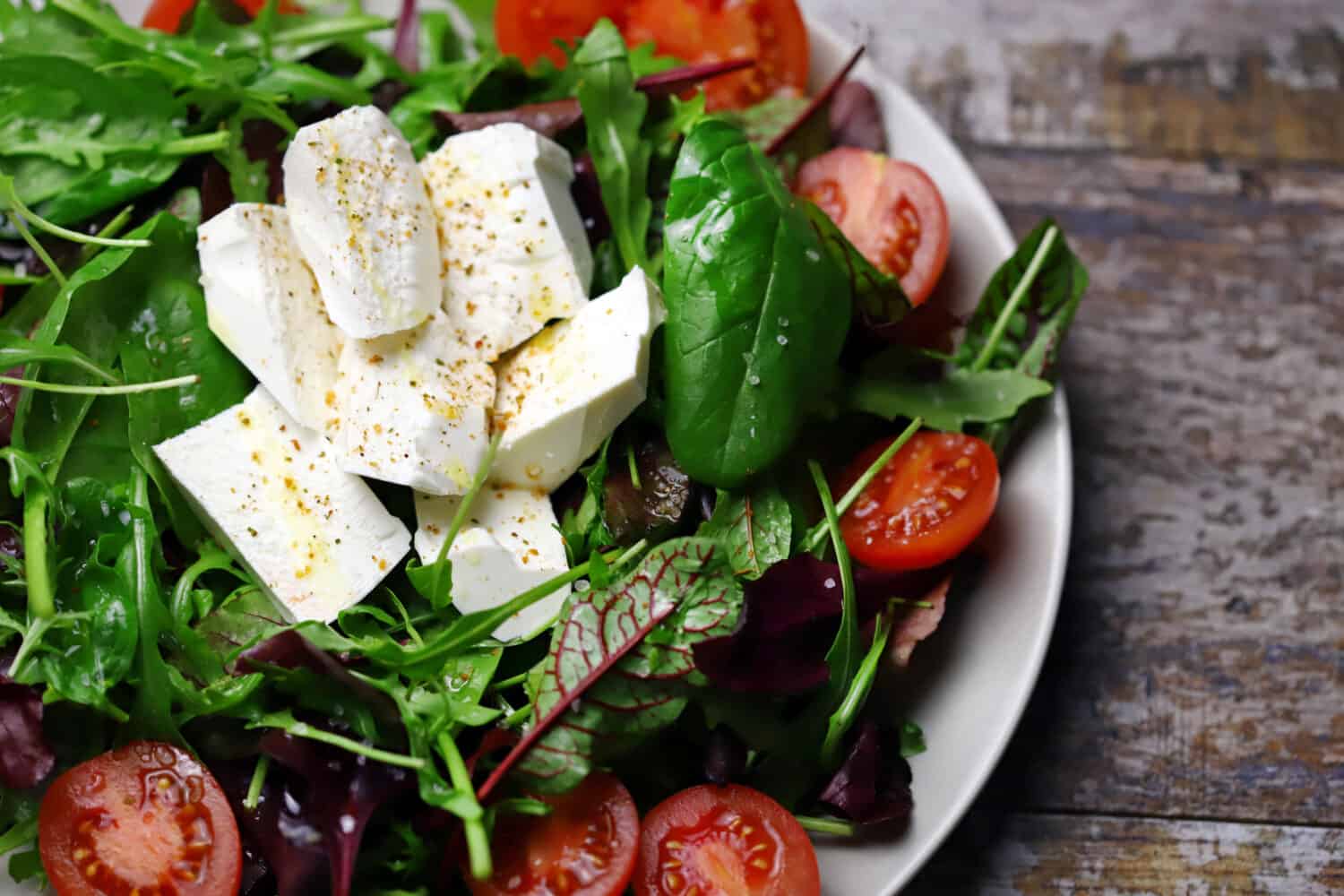
©223270637/Shutterstock.com
Feta cheese is a cheese that is primarily made from sheep's milk; it can also contain a small portion of goat's milk. However, it never contains cow's milk, which sets it apart from cotija. Feta is also placed in a brine solution, which gives it its signature salty flavor.
Origin
True feta cheese originates from Greece, making it a popular cheese for Mediterranean-style dishes. However, this cheese is now manufactured all over the world, meaning it can range in texture and flavor depending on where it's produced.
Characteristics and Texture
Feta cheese is typically firm, white, and crumbly. Greek feta cheese can be difficult to spread and may have a grainy texture to it.
Other types of feta cheese can vary in texture. For instance, French feta tends to be mild and creamier, while Bulgarian feta can be slightly less salty. What kind of feta cheese you purchase and use will depend on where it's produced.
Flavor
Feta typically has a tangy, sharp, and salty flavor. The saltiness comes from the brine solution that is used for aging, and the level of saltiness will depend again on where and how the cheese is made.
Both cotija and feta are aged cheeses which can give them a similar salty flavor as long as the cotija has not aged too long.
Production
Similar to cotija, the process of making feta cheese starts by curdling milk with rennet. Feta's curds, however, are allowed to drain in cheesecloth for several hours. The cheese is often cut into blocks or cubes which is typically how it's sold after it's aged. Once the cheese is cut, it's placed in a brine solution made from water and salt. This solution helps to preserve the cheese and gives it its characteristic flavor and texture.
Popular Uses
Feta cheese is popular for its versatility. It can be found in everything from salads and sandwiches to pasta and pies. It pairs well with a variety of ingredients, such as olives, tomatoes, and cucumbers, and is often used in Mediterranean-style cuisine.
Nutritional Value
While feta cheese still offers nutritional value like calcium and protein, it's also high in sodium and should be consumed in moderation. It is, however, lower in saturated fat and calories than cotija, making it a healthier option.
Can You Substitute Cotija for Feta and Vice Versa?
Depending on the recipe, yes, you can substitute these cheeses for each other. However, these two cheeses have distinct differences in flavor and texture, so they may not be the best substitutes for each other in all cases.
For example, aged cotija more closely resembles parmesan than feta, so depending on your recipe and your needs, you may not be able to substitute these cheeses for each other.
- The must-have convenient reference guide for every home cook!
- Includes more than 8,000 substitutions for ingredients, cookware, and techniques.
- Save time and money on by avoiding trips to grab that "missing" ingredient you don't really need.
What Are Some Other Substitutes for Cotija and Feta?
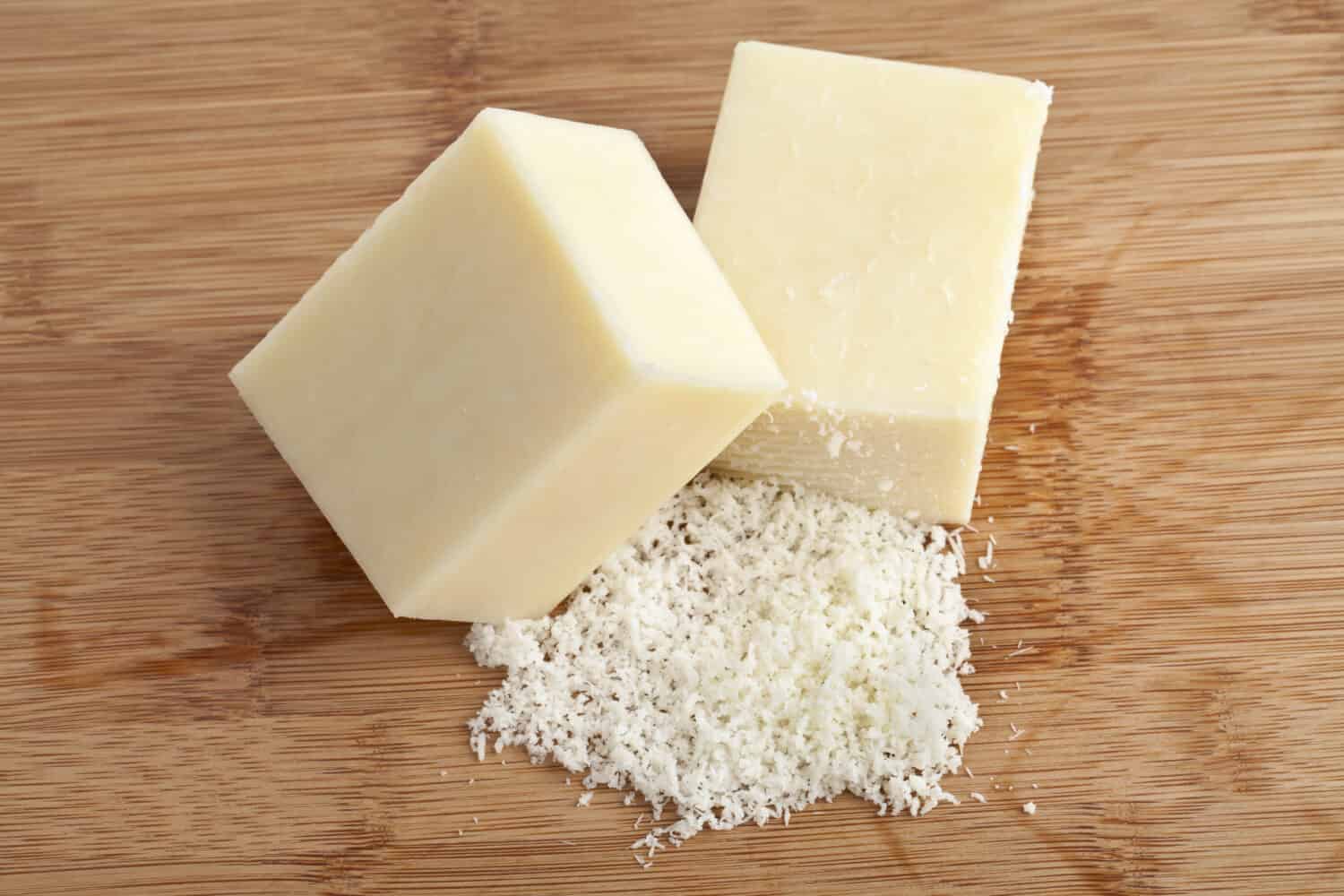
©Toasted Pictures/Shutterstock.com
Looking for another alternative in your recipe or unsure if feta is the best substitute for cotija? Here are a few other options if you're in a pinch or looking to try something different.
Parmesan Cheese
Parmesan cheese is the best substitute for aged cotija. It has a similar salty flavor and crumbly texture that can work well as a topping for Mexican dishes.
Queso Fresco
Queso fresco is a soft, mild cheese that is often used in Mexican cuisine as a topping for tacos and salads. It has a similar texture to cotija cheese, although it is less salty and has a milder flavor.
Halloumi
If you're looking for a substitute for feta cheese, halloumi cheese is a good option. It has a similar salty flavor and firm texture, although it is less tangy than feta. Halloumi cheese is often used in Mediterranean cuisine as a grilling cheese, and it can be sliced and added to salads and other dishes.
Goat Cheese
Goat cheese is a soft, tangy cheese that can be used as a substitute for feta cheese in salads, dips, and other dishes. It has a similar crumbly texture and tangy flavor that can add a unique twist to your dishes.
Ricotta Salata
Ricotta salata is a salty, crumbly cheese that is often used in Italian cuisine as a topping for salads, pasta, and other dishes. It has a similar texture to feta cheese, although it is less tangy with a slightly milder flavor.
Cotija Recipes
- Add cotija as a topping on these taco-stuffed baked potatoes.
- Sprinkle cotija on top of this taco soup recipe for an added twist.
Feta Cheese Recipes
Print
Fast Fresh Penne with Feta
Ingredients
6 ounces uncooked penne pasta
1/2 pound fresh mushrooms, sliced
1 Tablespoon olive oil
1 can (14 1/2 ounces) diced tomatoes, undrained
1 teaspoon dried basil
1/4 teaspoon salt
1/3 cup crumbled feta cheese
Instructions
1. Cook pasta according to package directions. While pasta is cooking sauté mushrooms in oil in a large skillet for 5 minutes.
2. Add the tomatoes, basil and salt. Cook and stir for 5 minutes.
3. Drain pasta and add to the skillet. Stir in the cheese, heat through.
4. Serve with warm buttered Italian bread or rolls. Makes 4 servings.
Final Thoughts
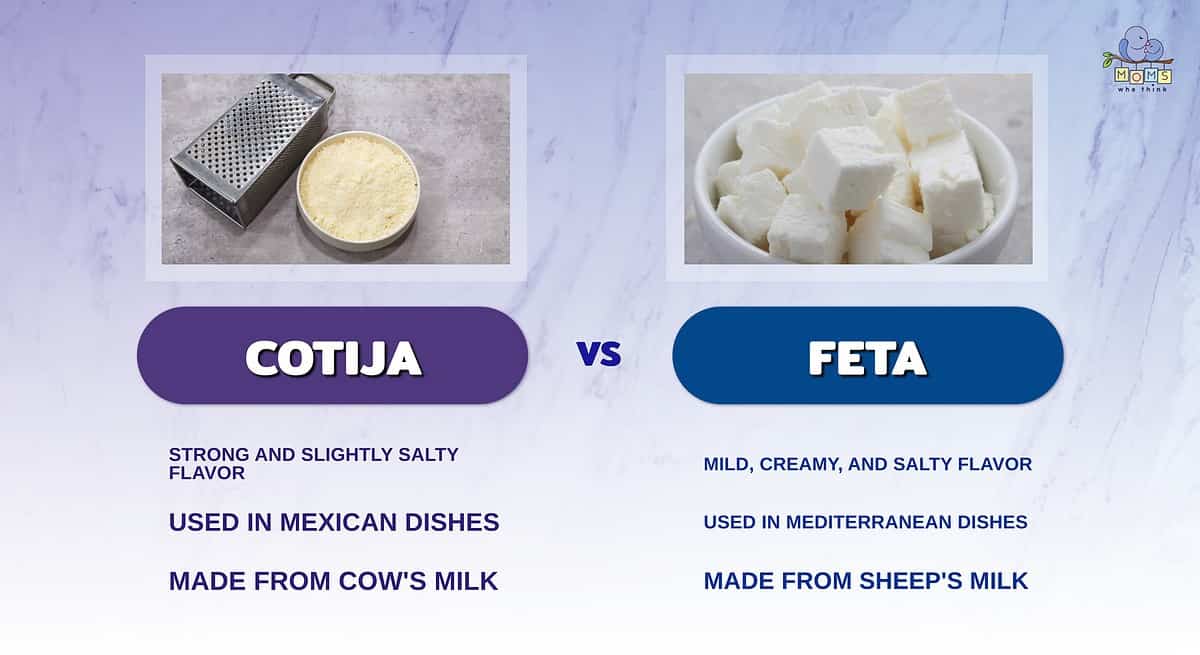
- Cotija cheese has a strong and slightly salty flavor. The flavor of feta cheese can vary depending on the variety, but it's typically a mild, creamy cheese with some saltiness.
- Feta cheese is most commonly used in Mediterranean dishes, while cotija enjoys use in Mexican cuisine.
- Some people may not realize that feta is actually made from sheep's milk! Cotija is made from cow's milk, putting it in the same category as many popular cheeses.
Cotija and feta are both delicious and versatile cheeses that can add a unique twist to your dishes. While they share some similarities, they also have distinct differences in flavor, texture, and origin that make them useful for different types of dishes. Ultimately, cotija and feta are both worth trying in your next recipe.
